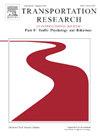评估刹车灯闪烁频率对视觉黑暗适应过程中认知显著性的影响:一项360度模拟驾驶研究
IF 4.4
2区 工程技术
Q1 PSYCHOLOGY, APPLIED
Transportation Research Part F-Traffic Psychology and Behaviour
Pub Date : 2025-02-25
DOI:10.1016/j.trf.2025.02.016
引用次数: 0
摘要
进入隧道入口和过渡区后,驾驶员会经历“黑洞效应”,由于照明减少,需要进行视觉适应。这种现象增加了追尾碰撞的风险。虽然刹车灯对交通安全至关重要,但在黑暗适应条件下提高能见度的策略需要进一步研究。现有的研究主要集中在刹车灯的一般性能和效果上。然而,关于制动灯的最佳闪烁频率的结论性结果仍然难以捉摸。本研究通过两个360°视频虚拟现实模拟驾驶实验,评估了闪烁刹车灯对不同隧道区域车辆显著性的影响:一个是搜索显著性实验(N = 30),评估驾驶员对刹车灯的反应时间,另一个是注意显著性实验(N = 34)。对眼动追踪数据和制动响应时间的分析表明,与隧道内的恒定灯相比,闪烁制动灯显著提高了车辆的可视性。在入口区,高频(10 Hz)和低频(4 Hz)闪烁制动灯在制动时间、首次注视时间(TTF)、注视时间或注视次数方面无显著差异。然而,在过渡区,与低频闪烁和恒定闪烁相比,高频闪烁导致反应时间更短,TTF更短,注视持续时间更长,注视次数增加,表明搜索和注意显著性增强。这些结果为设计制动灯闪烁频率以提高隧道行车安全提供了实证依据。本文章由计算机程序翻译,如有差异,请以英文原文为准。
Evaluating the effects of brake light flicker frequency on cognitive conspicuity during visual dark adaptation: A 360-degree simulated driving study
Upon entering tunnel entrance and transition zones, drivers experience the “black hole effect” which necessitates visual adaptation due to reduced illumination. This phenomenon increases the risk of rear-end collisions. While the brake lights are crucial for traffic safety, strategies to enhance visibility under dark adaptation conditions require further investigation. Existing research has primarily focused on the general properties and effects of the brake lights. However, conclusive results regarding the optimal flicker frequency for the brake lights remain elusive.
This study evaluates the impact of the flicker brake lights on vehicle conspicuity across various tunnel zones using two simulated driving experiments in 360° video-based Virtual Reality: a search conspicuity experiment (N = 30) assessing drivers’ reaction times to the brake lights, and an attention conspicuity experiment (N = 34). Analysis of eye-tracking data and braking response time reveals that flicker brake lights significantly improve vehicle conspicuity compared to constant lights across tunnel. In the entrance zone, no significant differences in braking time, time to first fixation (TTF), fixation durations, or fixation counts were observed between higher frequency (10 Hz) and lower frequency (4 Hz) flicker brake lights. In the transition zone, however, higher frequency flicker lights resulted in shorter reaction times, shorter TTF, longer fixation durations, and increased fixation counts in comparison to lower frequency flicker lights and constant lights, indicating enhanced search and attention conspicuity.
These results provide evidence-based insights for designing brake light flicker frequencies to enhance drive safety during tunnel driving.
求助全文
通过发布文献求助,成功后即可免费获取论文全文。
去求助
来源期刊
CiteScore
7.60
自引率
14.60%
发文量
239
审稿时长
71 days
期刊介绍:
Transportation Research Part F: Traffic Psychology and Behaviour focuses on the behavioural and psychological aspects of traffic and transport. The aim of the journal is to enhance theory development, improve the quality of empirical studies and to stimulate the application of research findings in practice. TRF provides a focus and a means of communication for the considerable amount of research activities that are now being carried out in this field. The journal provides a forum for transportation researchers, psychologists, ergonomists, engineers and policy-makers with an interest in traffic and transport psychology.

 求助内容:
求助内容: 应助结果提醒方式:
应助结果提醒方式:


